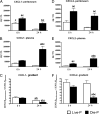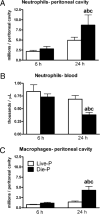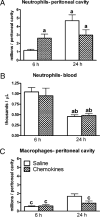Early enhanced local neutrophil recruitment in peritonitis-induced sepsis improves bacterial clearance and survival
- PMID: 21041722
- PMCID: PMC5540308
- DOI: 10.4049/jimmunol.1002300
Early enhanced local neutrophil recruitment in peritonitis-induced sepsis improves bacterial clearance and survival
Abstract
Neutrophils are critical for the rapid eradication of bacterial pathogens, but they also contribute to the development of multiple organ failure in sepsis. We hypothesized that increasing early recruitment of neutrophils to the focus of infection will increase bacterial clearance and improve survival. Sepsis was induced in mice, using cecal ligation and puncture (CLP); blood samples were collected at 6 and 24 h; and survival was followed for 28 d. In separate experiments, peritoneal bacteria and inflammatory cells were measured. Septic mice predicted to die based on IL-6 levels (Die-P) had higher concentrations of CXCL1 and CXCL2 in the peritoneum and plasma compared with those predicted to live (Live-P). At 6 h, Live-P and Die-P had equivalent numbers of peritoneal neutrophils and bacteria. In Die-P mice the number of peritoneal bacteria increased between 6 and 24 h post-CLP, whereas in Live-P it decreased. The i.p. injection of CXCL1 and CXCL2 in naive mice resulted in local neutrophil recruitment. When given immediately after CLP, CXC chemokines increased peritoneal neutrophil recruitment at 6 h after CLP. This early increase in neutrophils induced by exogenous chemokines resulted in significantly fewer peritoneal bacteria by 24 h [CFU (log) = 6.04 versus 4.99 for vehicle versus chemokine treatment; p < 0.05]. Chemokine treatment significantly improved survival at both 5 d (40 versus 72%) and 28 d (27 versus 52%; p < 0.02 vehicle versus chemokines). These data demonstrate that early, local treatment with CXC chemokines enhances neutrophil recruitment and clearance of bacteria as well as improves survival in the CLP model of sepsis.
Conflict of interest statement
The authors have no financial conflicts of interest.
Figures








Similar articles
-
Aberrant inflammation and lethality to septic peritonitis in mice lacking STAT3 in macrophages and neutrophils.J Immunol. 2003 Dec 1;171(11):6198-205. doi: 10.4049/jimmunol.171.11.6198. J Immunol. 2003. PMID: 14634136
-
Immunomodulatory role of CXCR2 during experimental septic peritonitis.J Immunol. 2003 Oct 1;171(7):3775-84. doi: 10.4049/jimmunol.171.7.3775. J Immunol. 2003. PMID: 14500678
-
Expression and contribution of endogenous IL-13 in an experimental model of sepsis.J Immunol. 2000 Mar 1;164(5):2738-44. doi: 10.4049/jimmunol.164.5.2738. J Immunol. 2000. PMID: 10679115
-
Neutrophil Recruitment: From Model Systems to Tissue-Specific Patterns.Trends Immunol. 2019 Jul;40(7):613-634. doi: 10.1016/j.it.2019.04.010. Epub 2019 Jun 4. Trends Immunol. 2019. PMID: 31175062 Free PMC article. Review.
-
The Septic Neutrophil-Friend or Foe.Shock. 2021 Feb 1;55(2):147-155. doi: 10.1097/SHK.0000000000001620. Shock. 2021. PMID: 32769816 Review.
Cited by
-
High Mobility Group Box-1 mediates hyperoxia-induced impairment of Pseudomonas aeruginosa clearance and inflammatory lung injury in mice.Am J Respir Cell Mol Biol. 2013 Mar;48(3):280-7. doi: 10.1165/rcmb.2012-0279OC. Epub 2012 Oct 18. Am J Respir Cell Mol Biol. 2013. PMID: 23087050 Free PMC article.
-
Hypertonic saline solution drives neutrophil from bystander organ to infectious site in polymicrobial sepsis: a cecal ligation and puncture model.PLoS One. 2013 Sep 17;8(9):e74369. doi: 10.1371/journal.pone.0074369. eCollection 2013. PLoS One. 2013. PMID: 24069301 Free PMC article.
-
Neutrophil extracellular trap-microparticle complexes enhance thrombin generation via the intrinsic pathway of coagulation in mice.Sci Rep. 2018 Mar 5;8(1):4020. doi: 10.1038/s41598-018-22156-5. Sci Rep. 2018. PMID: 29507382 Free PMC article.
-
Role of surfactant proteins A and D in sepsis-induced acute kidney injury.Shock. 2015 Jan;43(1):31-8. doi: 10.1097/SHK.0000000000000270. Shock. 2015. PMID: 25255378 Free PMC article.
-
Mice Lacking γδ T Cells Exhibit Impaired Clearance of Pseudomonas aeruginosa Lung Infection and Excessive Production of Inflammatory Cytokines.Infect Immun. 2020 May 20;88(6):e00171-20. doi: 10.1128/IAI.00171-20. Print 2020 May 20. Infect Immun. 2020. PMID: 32229615 Free PMC article.
References
-
- Fearon DT, Locksley RM. The instructive role of innate immunity in the acquired immune response. Science. 1996;272:50–53. - PubMed
-
- Hoffmann JA, Kafatos FC, Janeway CA, Ezekowitz RA. Phylogenetic perspectives in innate immunity. Science. 1999;284:1313–1318. - PubMed
-
- Weiss SJ. Tissue destruction by neutrophils. N Engl J Med. 1989;320:365–376. - PubMed
Publication types
MeSH terms
Substances
Grants and funding
LinkOut - more resources
Full Text Sources
Medical
Miscellaneous

